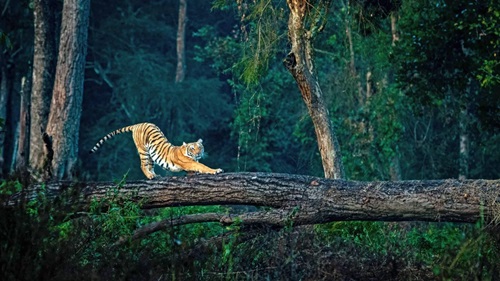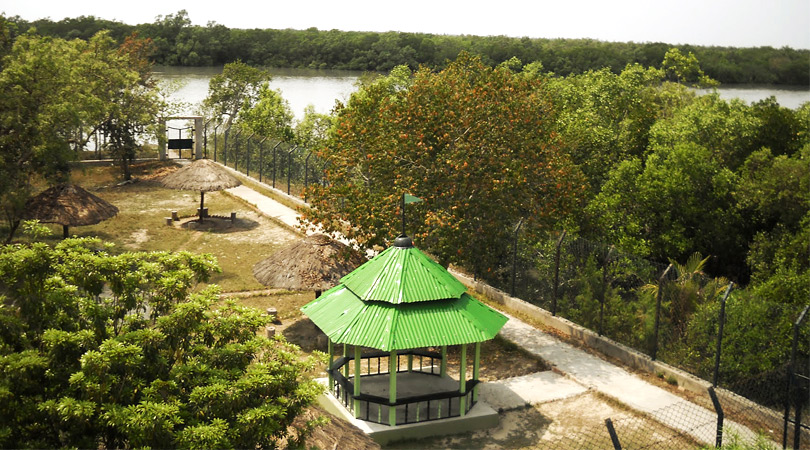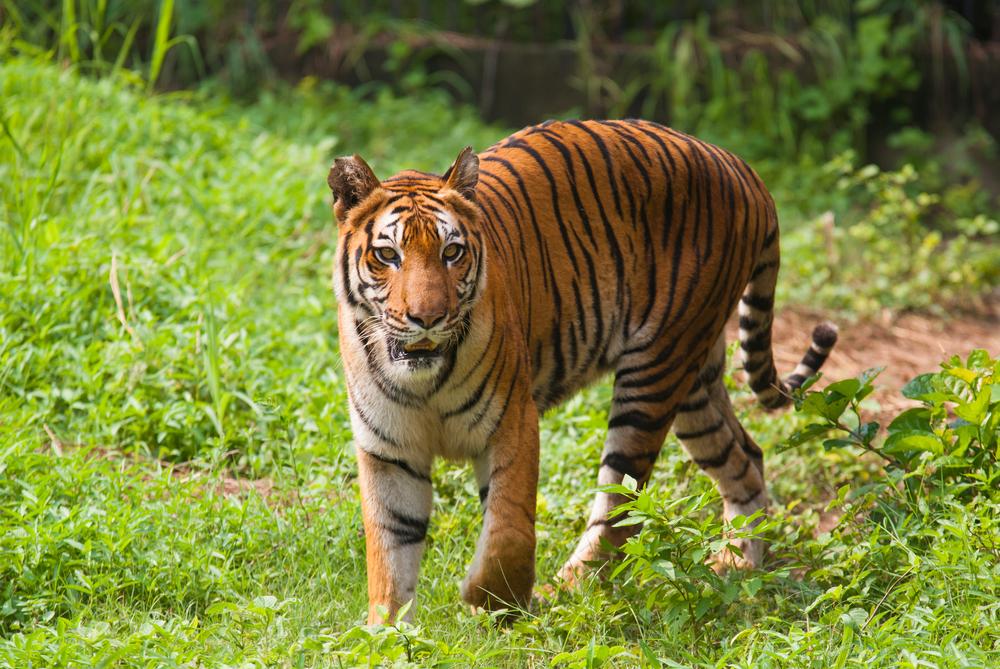About Sundarbans National Park
Sundarbans National Park, located in the delta region of West Bengal, India, is a UNESCO World Heritage Site and one of the largest mangrove forests in the world. Spanning approximately 1,330 square kilometers, it is renowned for its population of the elusive Bengal tiger, as well as other wildlife such as saltwater crocodiles, spotted deer, and various bird species.
The park's dense mangroves and complex network of waterways create a unique and challenging environment for both its inhabitants and visitors. Sundarbans is not only a critical habitat for endangered species but also plays a vital role in protecting the region from coastal erosion and storms.

Experience Top Tours

16 days India
Just Tigers and Golden Triangle Tour
New Delhi | Pench | Kanha | Bandhavgarh | Agra | Jaipur

12 days India
Corbett, Kanha & Bandhavgarh Tour - Tiger Safari Tour
New Delhi | Corbett | Kanha | Bandhavgarh | Jabalpur

13 days India
Corbett, Taj Mahal, Ranthambore & Jaipur Tour
New Delhi | Corbett | Agra | Ranthambore | Jaipur

8 days India
Golden Triangle & Tiger Safari: Delhi, Agra, Jaipur & Ranthambore
Delhi | Agra | Jaipur | Ranthambore | Delhi


11 days India
Tiger Safari Tour: New Delhi, Pench, Kanha & Bandhavgarh
New Delhi | Pench | Kanha | Bandhavgarh | Jabalpur
Highlights
Bengal Tigers
Bengal tigers in Sundarbans are powerful swimmers, adapted to the mangrove environment, and are the park's most iconic species.
Mangrove Forests
Mangrove forests in Sundarbans, a vital coastal ecosystem, protect against erosion and storms, supporting diverse wildlife and biodiversity.
Rich Birdlife
Rich birdlife in Sundarbans includes over 250 species, with kingfishers, herons, and rare birds thriving in diverse habitats.
UNESCO World Heritage Site
UNESCO World Heritage Site status recognizes Sundarbans for its unique mangrove ecosystem, rich biodiversity, and global conservation significance.
Famous Animals of Sundarbans
Popular Attractions To Visit in Dudhwa

Sajnekhali Bird Sanctuary
Sajnekhali Bird Sanctuary, located within the Sundarbans, is a prime spot for birdwatching. It hosts a diverse array of bird species, including kingfishers, herons, and egrets. The sanctuary also features a watchtower for better viewing and a visitor center, making it an essential stop for nature enthusiasts. Read more
Bharat Sevashram Sangha Temple
Bharat Sevashram Sangha Temple in Sundarbans is a spiritual site offering tranquility amidst the mangrove forests. Managed by the Bharat Sevashram Sangha, the temple provides a space for worship, reflection, and community service. It plays a key role in local humanitarian activities and promotes spiritual growth and cultural heritage. Read more


Sudhanyakhali Watch Tower
Sudhanyakhali Watch Tower is a prominent observation point in Sundarbans National Park. Located in a key wildlife area, it offers panoramic views of the surrounding mangroves and wildlife. Visitors can spot Bengal tigers, saltwater crocodiles, and various bird species from the tower, making it a popular spot for wildlife enthusiasts and photographers. Read more
Frequently Asked Questions
Q.What makes Sundarbans National Park unique?
Ans. Sundarbans National Park, located in West Bengal, is a UNESCO World Heritage Site and part of the largest mangrove forest in the world. It is famous for its Royal Bengal Tigers, which have adapted to the mangrove habitat, and its network of tidal rivers, creeks, and islands.
Q.What is the best time to visit Sundarbans National Park?
Ans. The best time to visit is from November to March, when the weather is cool and pleasant. This is also the peak season for wildlife sightings, including tigers and migratory birds. The monsoon season (June to September) should be avoided due to heavy rains and flooding.
Q. How can I explore Sundarbans National Park?
Ans. Exploring Sundarbans is done primarily through boat safaris, as the park is a network of waterways. Guided boat tours, ranging from half-day to multi-day trips, are the best way to observe the unique ecosystem and wildlife.
Q. What wildlife can I expect to see in Sundarbans?
Ans. Sundarbans is home to:
- Royal Bengal Tigers
- Saltwater Crocodiles
- Fishing Cats
- Spotted Deer
- Gangetic Dolphins
- Monitor Lizards
- Over 260 bird species, including kingfishers, herons, and migratory birds.
Q. Are there accommodations available near Sundarbans?
Ans. Yes, several eco-lodges, resorts, and budget accommodations are available near the park in villages like Gosaba and Pakhiralay. Houseboats are also an option for an immersive experience.
Q. Can I visit Sundarbans with children?
Ans. Yes, Sundarbans can be a family-friendly destination. Boat safaris are safe for children, but parents should keep an eye on them and follow all safety guidelines during the trip.
Q. What should I pack for a trip to Sundarbans?
Ans. Pack essentials such as:
- Light and breathable clothing
- Comfortable shoes
- A hat, sunglasses, and sunscreen
- Binoculars for wildlife spotting
- A waterproof bag for electronics and valuables
Q.What precautions should I take during my visit?
Ans.
- Follow all safety guidelines provided by your guide.
- Avoid venturing into restricted areas.
- Wear life jackets during boat safaris.
- Do not feed or disturb wildlife.
Q. What cultural experiences can I explore near Sundarbans?
Ans.
- Bonbibi Pujas: Local rituals dedicated to Bonbibi, the forest goddess.
- Village Tours: Experience the lifestyle of local communities who depend on the forest and rivers.
- Handicrafts and Honey Collection: Learn about traditional crafts and honey gathering from the mangroves.
Q. What is Sundarbans’ role in tiger conservation?
Ans. The Sundarbans is a critical habitat for the Royal Bengal Tiger and is part of Project Tiger, India’s flagship conservation program. It plays a vital role in protecting this iconic species and balancing the delicate mangrove ecosystem.
Sundarbans National Park offers a unique blend of adventure, biodiversity, and cultural experiences, making it a must-visit destination for nature lovers and adventure seekers.














